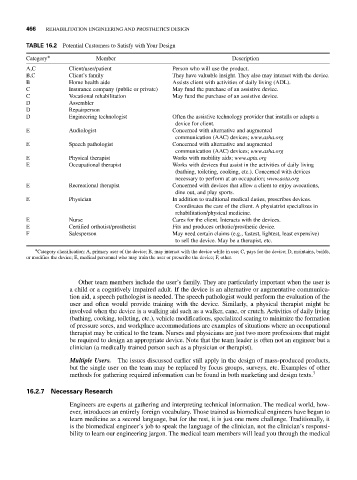Page 488 - Biomedical Engineering and Design Handbook Volume 2, Applications
P. 488
466 REHABILITATION ENGINEERING AND PROSTHETICS DESIGN
TABLE 16.2 Potential Customers to Satisfy with Your Design
Category ∗ Member Description
A,C Client/user/patient Person who will use the product.
B,C Client’s family They have valuable insight. They also may interact with the device.
B Home health aide Assists client with activities of daily living (ADL).
C Insurance company (public or private) May fund the purchase of an assistive device.
C Vocational rehabilitation May fund the purchase of an assistive device.
D Assembler
D Repairperson
D Engineering technologist Often the assistive technology provider that installs or adapts a
device for client.
E Audiologist Concerned with alternative and augmented
communication (AAC) devices; www.asha.org
E Speech pathologist Concerned with alternative and augmented
communication (AAC) devices; www.asha.org
E Physical therapist Works with mobility aids; www.apta.org
E Occupational therapist Works with devices that assist in the activities of daily living
(bathing, toileting, cooking, etc.). Concerned with devices
necessary to perform at an occupation; www.aota.org
E Recreational therapist Concerned with devices that allow a client to enjoy avocations,
dine out, and play sports.
E Physician In addition to traditional medical duties, prescribes devices.
Coordinates the care of the client. A physiatrist specializes in
rehabilitation/physical medicine.
E Nurse Cares for the client. Interacts with the devices.
E Certified orthotist/prosthetist Fits and produces orthotic/prosthetic device.
F Salesperson May need certain claims (e.g., fastest, lightest, least expensive)
to sell the device. May be a therapist, etc.
∗ Category classification: A, primary user of the device; B, may interact with the device while in use; C, pays for the device; D, maintains, builds,
or modifies the device; E, medical personnel who may train the user or prescribe the device; F, other.
Other team members include the user’s family. They are particularly important when the user is
a child or a cognitively impaired adult. If the device is an alternative or augmentative communica-
tion aid, a speech pathologist is needed. The speech pathologist would perform the evaluation of the
user and often would provide training with the device. Similarly, a physical therapist might be
involved when the device is a walking aid such as a walker, cane, or crutch. Activities of daily living
(bathing, cooking, toileting, etc.), vehicle modifications, specialized seating to minimize the formation
of pressure sores, and workplace accommodations are examples of situations where an occupational
therapist may be critical to the team. Nurses and physicians are just two more professions that might
be required to design an appropriate device. Note that the team leader is often not an engineer but a
clinician (a medically trained person such as a physician or therapist).
Multiple Users. The issues discussed earlier still apply in the design of mass-produced products,
but the single user on the team may be replaced by focus groups, surveys, etc. Examples of other
methods for gathering required information can be found in both marketing and design texts. 7
16.2.7 Necessary Research
Engineers are experts at gathering and interpreting technical information. The medical world, how-
ever, introduces an entirely foreign vocabulary. Those trained as biomedical engineers have begun to
learn medicine as a second language, but for the rest, it is just one more challenge. Traditionally, it
is the biomedical engineer’s job to speak the language of the clinician, not the clinician’s responsi-
bility to learn our engineering jargon. The medical team members will lead you through the medical

